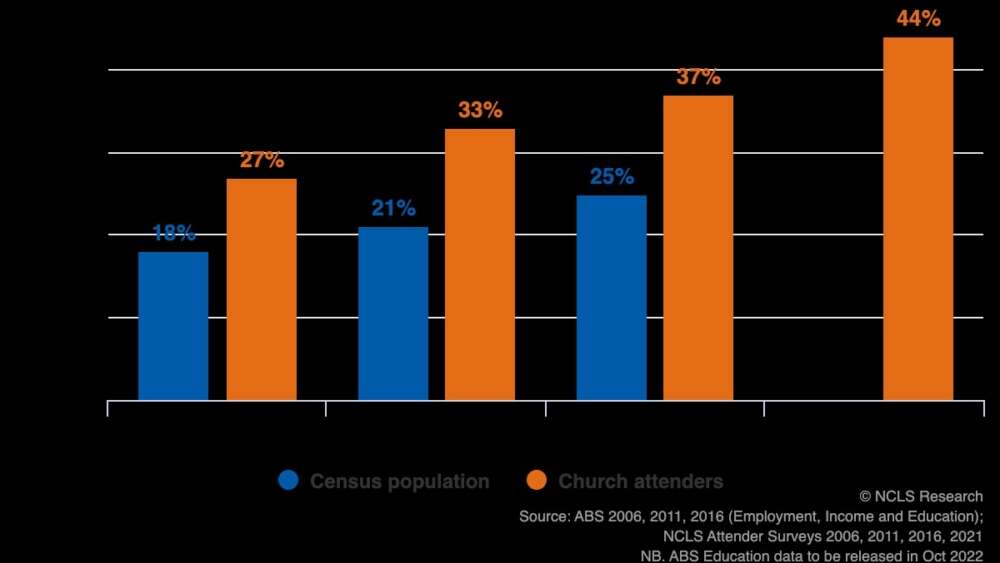Education gap making churches too middle class
Call to review training methods and service styles
The latest National Church Life Survey (NCLS) reveals an educational disparity between churchgoers and the surrounding community that makes the less educated feel unwelcome in our churches, according to Coz Crosscombe, Community Engagement Pastor with the Anglican Diocese of Sydney
“What we’ve seen is a gap between those who come to church and their educational levels and those in the surrounding communities where we find that those who go to church generally have a higher level of education or tertiary education,” he told a webinar held by NCLS Research.
In 2006, about 27 per cent of people who attended Australian churches and filled out the NCLS survey came from higher education backgrounds. In the latest 2021 survey, that figure had grown to 44 per cent; in Anglican churches, more than 50 per cent of all people 15 years or older had tertiary education.
“When they go to church, they’re looking for longer times where they can build relationships.” – Coz Crosscome
Crosscombe, who is also a minister in the Mt Druitt area of Sydney, said it’s time to recognise that a lot of churches are designed for the middle class. He pointed out that this creates challenges in reaching people from poorer communities or those from lower educational backgrounds.
“I think we’ve got to recognise that a lot of churches, not all, but a lot of churches are designed for the middle class. The service time, the way the services run, the style of preaching, the transactional nature [of teaching] are all there,” he said.
“I think we’ve missed that those in poor communities and those with lower education levels tend to be far more relational, and when they go to church, they’re looking for longer times where they can build relationships. They’re often coming in with larger relational needs, so they’re needing a stronger network and … more of a family atmosphere.”

Coz Crosscombe
While there were some positive things in the education gap, such as great university ministries and good support systems for immigrant communities, it also led to a limited number of churches and effective ministries working in poor communities.
“We find that even those churches in those communities tend to be dominated by those with a higher education background who might drive into that community. And so there’s a disparity there that we want to look at.”
“So I think we’ve got to re-look at our training systems and our deployment systems.” – Coz Crosscombe
While it was a complex issue with many dynamics, he felt one of the big problems was how we train clergy.
“We use a higher education training style for ministers across the city. This is not restricted just to the Anglican church, but it’s prevalent in other churches. Because of that, we tend to find people who are attracted to higher education and while they’re in seminaries, we tend to grade them based upon how well they do in higher education styles,” he said.
“So we affirm that that back. And then, we deploy them into communities. Most often, they’re going to want to go back into communities similar to where they came from, which tend not to be the lower educated and poor communities in the city.
“We also often are teaching what’s called a homogenous principle or sweet spot ministry. There might be another way of putting it where we help people say, ‘Well, you’re going to reach people most like you,’ and if we’re already deploying people who have a higher education level, it’s most likely they’re going to be reaching out to people who also have a higher education background. And so that will continue that disparity.
“They’re also most likely to put other people in leadership who will be like them because they see their strengths and giftings in others. So the leadership of the church, not just the minister but the actual leadership, will tend to skew in that direction.”
What we miss in this is that people in poor communities who haven’t been in the higher education system can be just as phenomenal leaders, Crosscombe said. In fact, he has found that thriving spiritual communities in most of the world are poor.
“So I think we’ve got to re-look at our training systems and our deployment systems.”
In terms of how church services are run, he says less educated people tend to react more and develop more around preaching that goes to the emotion and less into the intellect. “I’ve heard numerous times from people who come from low education backgrounds who say they go to church and they feel like they’re at school and sitting in the back, being a dumb kid who doesn’t know the answers.
“In fact, on Sunday, I watched somebody walk out of a church because they’d started a trivia and they said, ‘it just makes me feel dumb.’ So we need to think and understand that perhaps our whole style has been slanted more towards one group. And because of that, others don’t feel welcome in our churches. They don’t feel like the church engages them where they’re at.
“That can be a language thing. It can be a cultural and contextual thing for some of our communities. It’s just the fact that we don’t have churches in locations where people can access them. If you’re using public transportation to get to church on Sunday mornings, it’s about the worst time to try and catch public transport. So what might be a five or 10 minute drive for one person, could be an hour long journey for another to get to church.
‘So we’ve got to recognize those factors. There’s a whole bunch more. It’s very complex. It’s certainly a really challenging thing and one that we want to address and want to address with other churches and other denominations.”
Email This Story
Why not send this to a friend?


